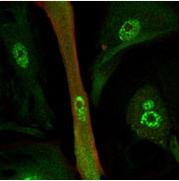Reprogramming brain cells to become heart cells
July 11, 2011

tCardiomyocyte (center), showing protein distribution (green and red colors) indicative of a young cardiomyocyte (credit: Tae Kyung Kim, Perelman School of Medicine, University of Pennsylvania)
The direct conversion of a non-heart cell type into a heart cell by RNA transfer has been demonstrated by researchers at the Perelman School of Medicine at the University of Pennsylvania.
The team first extracted mRNA from a heart cell, then put it into astrocytes or fibroblasts (brain cells). Because there were so many more heart-cell mRNAs versus astrocyte or fibroblast mRNAs, the heart-cell mRNAs took over the indigenous RNA population, which were then translated into heart-cell proteins in the cell cytoplasm. These heart-cell proteins then influenced gene expression in the host nucleus so that heart-cell genes were turned on and heart-cell-enriched proteins were made.
To track the change from an astrocyte to heart cell, the team looked at the new cells’ RNA profile using single cell microarray analysis, cell shape, and immunological and electrical properties.
The hope is to use this process to permit personalized screening for efficacy of drug treatments, screening of new drugs, and potentially as a cellular therapeutic, the researchers said.
Ref.: J. H. Eberwine, et al., Transcriptome transfer provides a model for understanding the phenotype of cardiomyocytes, PNAS, 2011; [DOI: 10.1073/pnas.1101223108]